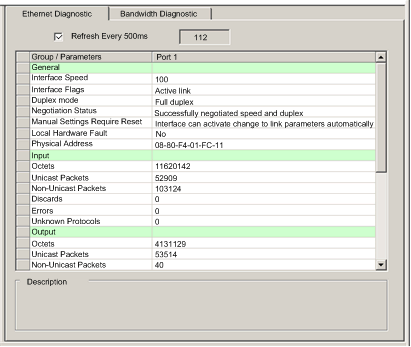|
Ethernet Port Diagnostics
|
|
|
(Original Document)
|
|
When the checkbox is...
|
This page...
|
|---|---|
|
Selected
|
|
|
De-selected
|
|

|
Step
|
Action
|
|---|---|
|
1
|
In the DTM Browser, select the communication module and click the right mouse button. A pop-up menu opens.
|
|
2
|
In the menu, select Device menu → Diagnostic.
|
|
3
|
In the left pane of the Diagnostic window, select the communication module node.
|
|
4
|
Click on the Ethernet Diagnostic tab to open that page.
|
|
Parameter
|
Description
|
|---|---|
|
General parameters:
|
|
|
Interface Speed
|
Valid values include: 0, 10, 100 Mbits/second
|
|
Interface Flags
|
Bit 0—Link Status: 0 = Inactive; 1 = Active
|
|
Bit 1—Duplex Mode (see below)
|
|
|
Bits 2...4—Negotiation Status (see below)
|
|
|
Bit 5—Manual Setting Requires Reset (see below)
|
|
|
Bit 6—Local Hardware Fault (see below)
|
|
|
Duplex Mode
|
0 = half duplex; 1 = full duplex
|
|
Negotiation Status
|
3 = successfully negotiated speed and duplex
4 = forced speed and link
|
|
Manual Setting Requires Reset
|
0 = automatic; 1 = device requires reset
|
|
Local Hardware Fault
|
0 = no event; 1 = event detected
|
|
Physical Address
|
Module MAC Address
|
|
Input parameters:
|
|
|
Octets
|
Octets received on the interface
|
|
Unicast Packets
|
Unicast packets received on the interface
|
|
Non-Unicast Packets
|
Non-unicast packets received on the interface
|
|
Discards
|
Inbound packets received on the interface, but discarded
|
|
Errors
|
Inbound packets that contain detected errors (excludes In Discards)
|
|
Unknown Protocols
|
Inbound packets with unknown protocol
|
|
Output parameters:
|
|
|
Octets
|
Octets received on the interface
|
|
Unicast Packets
|
Unicast packets received on the interface
|
|
Non-Unicast Packets
|
Non-unicast packets received on the interface
|
|
Discards
|
Inbound packets received on the interface, but discarded
|
|
Errors
|
Outbound packets that contain detected errors (excludes In Discards)
|
|
Unknown Protocols
|
Outbound packets with unknown protocol
|
|
Error counter parameters:
|
|
|
Alignment Errors
|
Frames that are not an integral number of octets in length
|
|
FCS Errors
|
Frames received that do not pass the FCS check
|
|
Single Collisions
|
Successfully transmitted frames that experienced exactly one collision
|
|
Multiple Collisions
|
Successfully transmitted frames that experienced more than one collision
|
|
SQE Test Errors
|
Number of times the SQE test error is detected
|
|
Deferred Transmissions
|
Frames for which first transmission attempt is delayed because the medium is busy
|
|
Late Collisions
|
Number of times a collision is detected later than 512 bittimes into the transmission of a packet
|
|
Excessive Collisions
|
Frames for which transmission does not succeed due to excessive collisions
|
|
MAC Transmit Errors
|
Frames for which transmission fails due to a detected internal MAC sublayer transmit error
|
|
Carrier Sense Errors
|
Times that the carrier sense condition was lost or not asserted when attempting to transmit a frame
|
|
Frame Too Long
|
Frames received that exceed the maximum permitted frame size
|
|
MAC Receive Errors
|
Frames for which reception on an interface does not succeed due to a detected internal MAC sublayer receive error
|